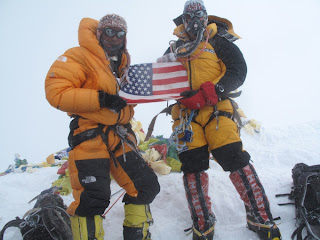

March 24 – 26: Travel from your home port to Kathmandu. All flights cross the dateline and a day is consequently lost. Arrive in Kathmandu, where a Mountain Madness guide will meet you. On your way to the hotel, we stop by our office, Mountain Madness Pvt. Nepal Ltd. Check into the Yak & Yeti Hotel, a classic five-star hotel located in the Durbar Marg district. Great food from all over the world, fabulous shopping and Durbur Square, with its numerous temples and markets, are nearby. March 27: While we wrap up last minute paperwork with the Nepal Government, you will have a casual day of shopping for souvenirs in the streets of Kathmandu, visiting the palaces, Thamel District, Hindu temples and shrines, Buddhist stupas, or just relaxing at the hotel. Favorite destinations are Swayambunath, a Buddhist temple with prayer flags descending from the highly ornate steeple and situated on a small hill that offers outstanding views of the city. Or you can join the thousands of Hindus who venture to the Pashupatinath temple, one of the most famous Hindu temples in Nepal and the most famous Shiva temple in Asia. March 28: We fly to the Himalayan foothills where we will begin our trek into the Khumbu region. The sights from the plane are amazing, providing panoramic views of terraced hills and the distant Himalayan giants. After landing in the village of Lukla (9,350 feet) we will meet our staff and porters and continue on about two and a half hours to Phakding (8,700 feet). March 29: We continue trekking along the banks of the Dudh Kosi, crossing this majestic river many times on wild suspension bridges laden with prayer flags. After entering Sagamartha National Park at Jorsale, the trail climbs steeply with breathtaking views up to Namche Bazaar, the gateway to the Khumbu region at 11,300 feet. March 30: Today is a rest and acclimatization day in Namche. Namche is a colorful village with many wonderful and interesting shops and vendors, fabulous food and stunning views of the surrounding mountains. An early hike above town before the clouds move in will reward climbers with a spectacular Himalayan sunrise and views of Everest, Lhotse (the 4th highest peak in the world), and the beautiful Ama Dablam. On the way down, we can visit the Sherpa Museum that displays an exhibit on traditional Sherpa lifestyle as well as a fabulous photography collection. A local Nepalese naturalist takes all photos, and in one room the Sherpa traditions are highlighted, while in another Sherpa high altitude climbers are presented. March 31: The trek continues along the Dudh Kosi with rushing clear blue rivers and magnificent views of the mountains. We will stay the night at Thyangboche monastery at 12,887 feet where you will find one of the best views in the world. Inside the monastery are incredibly ornate wall hangings, a 20-foot sculpture of Buddha, and the musical instruments and robes of the Lamas. If our group is lucky, we will get to see the Lama perform a ceremony and listen to the mystical chanting and music. Remember to bring lots of film! April 1: From Thyangboche the trail drops to Debuche, crosses a wild bridge on the Imja Khola, and then climbs to the village of Pangboche where incredible mani stones line the path. The uphill trek continues, taking us to the quaint traditional Sherpa village of Dingboche (14,250 feet) with its exquisite views of Lhotse, Island Peak, and Ama Dablam. April 2: Another rest day. There is the option of taking a light acclimatization hike up the valley for better photo shots of the valley and mountains of the Khumbu region. April 3: From Dingbouche, the trail traverses along farmlands and meadows before continuing up the terminal moraine of the Khumbu Glacier. Our path skirts along the glacier’s edge to the Italian Research Station where we are treated to great Italian food, showers and real beds! April 4: After an early morning start, we ascend Kala Pattar (18,450 feet) and enjoy famous views of the Himalayas; then descend from this viewpoint and continue on to Base Camp on Khumbu Glacier, at the foot of the icefall. April 5 - May 4: We arrive at Everest Base Camp (17,500 feet) on the jumbled moraine below the infamous Khumbu Icefall. There we spend some time acclimatizing. The next weeks are spent negotiating the Khumbu Icefall, entering the Western Cwm, and climbing to lofty Camp III (23,500 feet). Our objective for the next 3 to 4 weeks is to establish and stock three camps above base camp and to acclimatize for the climb to the summit. We sleep at Camp III for a night or two before heading down to base camp to rest before our summit bid. May 5 - 9: With everybody fit and acclimatized, we head back to base camp. For the next 5 days rest is top priority. We visit with trekkers, eat, rest, eat, rest, and prepare for the summit bid.May 10 - 31: We climb to camp II, then to camp III and finally to the South Col where we place our final camp at 26,000 feet. Our summit target date is between May 15 through the 25. We are prepared to stay at base camp to wait for good weather or until the monsoon arrives at the end of May. Mountain Madness service continues as we head back down to Kathmandu (3-5 days); we’ll fly out of Lukla. Hotel accommodations with breakfast and dinner in Kathmandu for the night of our return and the next night are included in your package. However, if individuals want to make a faster return to Kathmandu or deviate from the trek back down from other points along the way, they are free to do so at their own expense.
0 Comments for "Itinerary for Mt. Everest"
Post a Comment